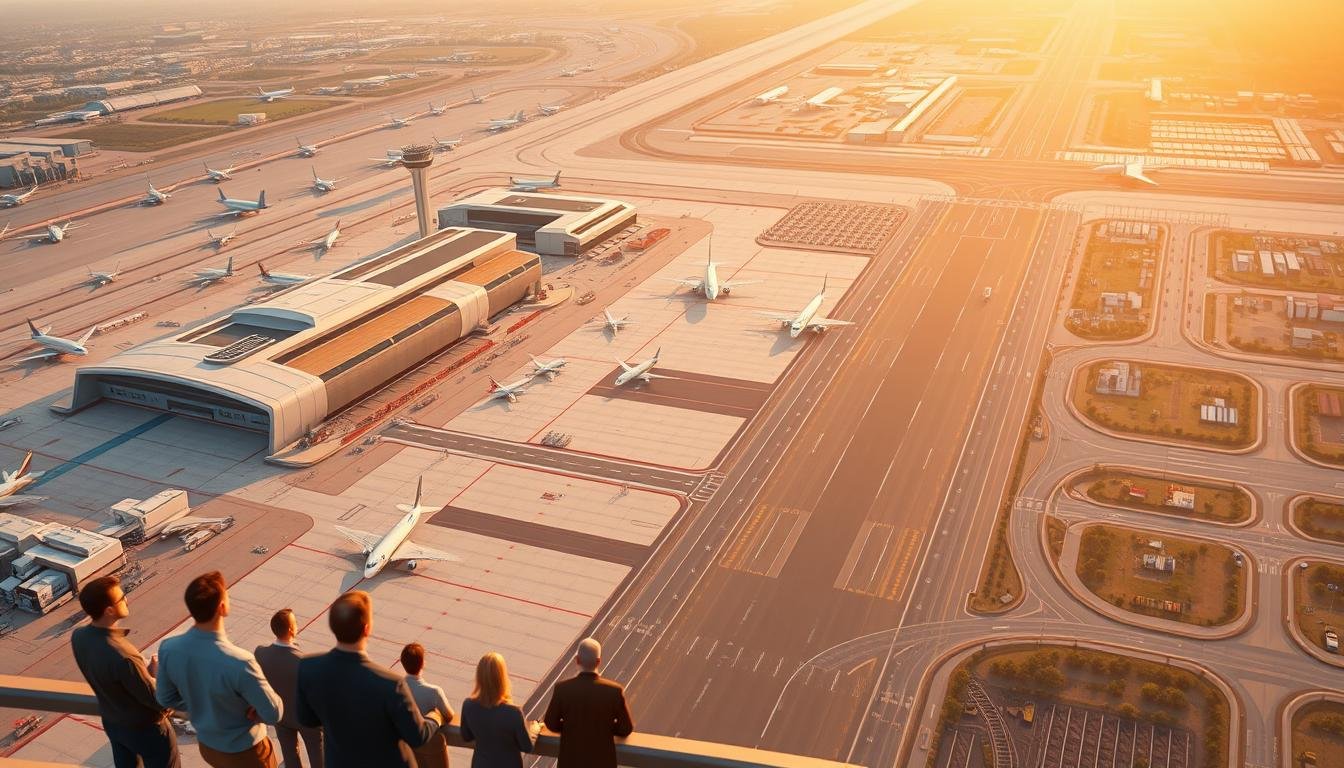Investing in aviation infrastructure
U.S. air travel has bounced back to 819.5 million passengers in 2023, beating pre-pandemic numbers. Experts predict 1.28 billion passengers by 2040. This means we need to invest in better aviation infrastructure fast.
The Infrastructure Investment and Jobs Act (IIJA) gave $25 billion for aviation projects. But, the FAA says we need $114 billion more over ten years.
It’s not just about more passengers. The FAA wants to spend $200 million a year on airport safety. The Passenger Facility Charge (PFC) fee has been the same since 2001. Some think raising it could help cover the $114 billion gap.
Public-private partnerships, like the $9.5 billion JFK expansion, show how we can work together. They offer chances for investing in the aviation industry.
Key Takeaways
- U.S. passenger numbers are projected to hit 1.28 billion by 2040, requiring urgent infrastructure upgrades.
- The IIJA’s $25 billion allocation addresses only part of the $310 billion needed through 2033.
- Raising the $4.50 PFC cap could bridge the $114 billion funding gap over ten years.
- P3 projects like JFK’s expansion show private-sector potential in aviation industry investments.
- Sustainability initiatives, including solar panels and carbon-neutral programs, are reshaping modern airports.
Understanding the Aviation Infrastructure Landscape
Aviation infrastructure is more than just runways and terminals. It includes control towers, navigation systems, cargo facilities, and access roads. These parts work together to support economic growth and keep travelers safe.
Key Components of Aviation Infrastructure
Airports need many systems to work well. Runways and taxiways let planes move, while air traffic control systems help avoid delays. Cargo facilities handle huge amounts of freight, and terminal buildings meet growing passenger needs. Access roads and parking structures help connect people to air travel.
Current State of US Aviation Infrastructure
- Over 13,000 airports exist nationally, but only 3,247 are federally prioritized via the NPIAS program.
- The Bipartisan Infrastructure Law allocated $25B since 2021, with recent grants like $7.9M for Buffalo Niagara’s road upgrades and $1.75M for Rome’s control tower repairs.
- Despite progress, FAA data shows a $67.5B capital needs gap for 2025-2029 alone.
Critical Infrastructure Needs and Gaps
A $114B funding shortfall is expected over the next decade. Old systems like outdated navigation and worn-out runways need fixing fast. There’s also a shortage of air traffic controllers, with 3,000 positions open. Investing in aviation infrastructure and aerospace capital projects could help. The FAA’s 2025-2029 plan shows where investors can make a big difference.
Why Investing in Aviation Infrastructure Matters Now
The aviation industry is key to the U.S. economy. In 2019, it supported 12.8 million jobs and brought in $619 billion in paychecks. With passenger numbers set to rise from 1 billion in 2025 to 1.7 billion by 2050, updating airports and air traffic systems is crucial. Aviation industry investments today will boost jobs and economic growth for years to come.
Airport development funding is getting a boost. The FAA’s $25 billion from the Infrastructure Investment and Jobs Act is starting projects like terminal upgrades. But, airports need $173.9 billion over five years to meet demand. Investing wisely can also help with sustainable tech, like electric vehicles and green energy.
| Economic Impact | Current Needs | Future Projections |
|---|---|---|
| 12.8M jobs supported | $173.9B needed by 2028 | 1.7B passengers by 2050 |
| $619B annual payroll | Modernizing PFC fees for inflation | Supersonic aircraft integration |
| $1.8T annual economic output | Advanced air mobility (AAM) funding | FAA tech upgrades |
Legislative efforts like the Advanced Air Mobility Coordination and Leadership Act show a federal push for innovation. Investors who invest now can get into new areas like drone logistics or hybrid-electric aircraft. With passenger numbers rising and new tech like AAM coming, aviation industry investments are timely for both economic recovery and future success. It’s time to act before demand outpaces outdated systems.
Companies like Kubick Aviation illustrate how local aviation providers are strengthening this larger infrastructure network. Through advanced maintenance operations, avionics upgrades, and flight services, they help regional airports and private operators stay aligned with the evolving standards of safety, sustainability, and technology—exactly what today’s investors look for when identifying long-term aviation growth opportunities.
Identifying Lucrative Investment Opportunities
Smart aviation infrastructure growth opportunities come from strategic upgrades. These upgrades boost efficiency and appeal. The U.S. is focusing on terminal overhauls, runway expansions, and tech upgrades.
These projects are backed by $1.2 trillion in federal funding from the IIJA. Here’s where to focus for strong returns.
| Project Type | Focus Areas | Key Benefits |
|---|---|---|
| Terminal Modernization | Retail spaces, security tech, lounge expansions | Increased passenger spending, shorter wait times |
| Runway Upgrades | Lengthening, widening, noise reduction tech | Higher aircraft capacity, reduced delays |
| ATM Systems | NextGen radar, digital tower systems | Fewer delays, safer flight paths |
| Sustainable Tech | Solar panels, SAF fuel stations, EV charging | Lower emissions, long-term cost savings |
Airport Terminal Modernization Projects
Terminals at JFK and LAX now have smart check-in kiosks and premium dining. Investors can partner with airports to develop these areas. For example, Dallas-Fort Worth added 50 new stores in Phase 1 of its $2.5B expansion.
Runway and Taxiway Improvements
- FAA targets 97.7% of runways to meet safety standards by 2025
- Chicago O’Hare’s $2.3B runway project reduced congestion by 30% since 2022
Air Traffic Management Systems
NextGen upgrades at 20 major hubs aim to cut fuel waste by 12%. This is through optimized flight paths. Boeing and Honeywell are testing AI-driven traffic control systems at Miami and Denver airports.
Sustainable Aviation Facilities
Emerging airline infrastructure investment includes green tech. This includes solar arrays at San Francisco Airport and SAF refueling stations at Seattle-Tacoma. Airlines like Delta now require 10% SAF blends by 2030, driving fuel infrastructure demand.
Assessing the Financial Potential of Airport Development Funding
Investors looking at airport development funding and airport expansion financing face a big challenge. They must weigh today’s needs against tomorrow’s demands. With the FAA predicting 1.3 billion passengers by 2044, careful financial planning is essential.
Important factors include return on investment, how long it takes to see returns, and trends that affect money coming in.
ROI Analysis for Aviation Projects
When looking at aviation projects, ROI is key. It looks at money from landing fees and other sources like retail and parking. Upgrading terminals or adding runways often needs airport expansion financing based on future growth.
For example, updating old facilities can make things run smoother. New runways help with the 14 major hubs facing capacity issues by 2033.
Long-term vs. Short-term Investment Horizons
| Short-Term Focus | Long-Term Focus |
|---|---|
| Quick revenue boosts (e.g., concessions) | Decades-long asset lifespans |
| Operational efficiency upgrades | Capacity for 2.5% annual traffic growth |
Short-term plans focus on saving money and quick improvements. Long-term goals tackle big issues like runway shortages at 11 airports by 2028.
Passenger Traffic Growth Projections
The FAA predicts a 48% increase in U.S. passenger flights by 2039. Airlines and investors need to match their funding with these forecasts. The recovery to pre-pandemic levels is expected, but projects must also prepare for future ups and downs.
- 1.3 billion annual passengers by 2044
- 75% of traffic concentrated in large hubs by 2039
- $2.7 trillion global economic impact of air transport
Successful plans combine these elements to boost returns while solving problems like runway limits and old infrastructure. Finding the right balance ensures steady income for years to come.
Aviation Infrastructure Financing Strategies
Financing aviation infrastructure needs a blend of old and new methods. The investing in aviation infrastructure world uses bonds, grants, and Passenger Facility Charges (PFCs). In 2020, airports used $13.3 billion in bonds for upgrades and expansions.
The Infrastructure Investment and Jobs Act (IIJA) added $25 billion. The Airport Improvement Program (AIP) gave out $3.9 billion in 2024.
New strategies like special purpose vehicles (SPVs) and revenue-sharing models are emerging. For example, Canada’s pension funds team up with authorities through joint ventures. The U.S. is exploring public-private partnerships (P3s) for infrastructure.
North America has a $92 billion pipeline for 962 projects. Investors face challenges like fuel costs and regulations. But, air traffic is expected to grow 5.7% annually until 2034.
Using a mix of funding, from bonds to private equity, helps projects move forward. It also meets community needs.
Public-Private Partnerships in Aviation
Public-private partnerships (PPPs) are changing how we invest in airline infrastructure in the U.S. The $9.5 billion New Terminal One project at JFK International Airport shows how these partnerships can update facilities and share costs. This approach is key as U.S. airports need $151 billion for upgrades over the next decade.
Successful PPP Case Studies in US Airports
- LaGuardia Airport’s Terminal B redevelopment, led by a private consortium, set a precedent for modernizing aging facilities.
- JFK’s New Terminal One will feature expanded retail and amenities, funded through private financing and public support.
- Rental car facilities at LAX and Newark Liberty have reduced taxpayer costs via P3 agreements.
Structuring Effective Partnership Agreements
Successful deals need clear terms:
- Concessions: Long-term leases (30–99 years) ensure steady revenue streams.
- Revenue sharing: Balancing investor returns with public benefits, like improved passenger access.
- Governance: Joint oversight committees ensure transparency and accountability.
Risk Allocation in Aviation PPPs
Risks must be shared fairly between partners. Private entities usually handle:
- Construction delays and cost overruns
- Operational performance targets
Public entities manage regulatory changes and demand fluctuations. Europe’s 75% passenger use of privatized airports shows potential for U.S. growth, where only 1% of passengers use P3 airports.
While tax-exempt bonds are not available for U.S. airports, global investors see potential. The aviation industry investments in P3s could bring needed upgrades, balancing public goals with private innovation.
Navigating Regulatory Considerations for Aerospace Capital Projects
The FAA Reauthorization Act of 2024 gave $105.5 billion for aviation projects. But, success comes from knowing the rules well. Aerospace projects must follow federal rules like the $4 billion AIP funding each year. They also need to meet state and local laws.
Important regulators include the FAA, ICAO, EASA, and national Civil Aviation Authorities. They require projects to pass environmental checks, noise rules, and safety tests. For instance, the FAA’s NextGen program needs projects to follow airspace standards in the NAS EA.
- Federal: FAA’s AIP funding and NextGen standards
- International: ICAO safety protocols (e.g., Annex 6)
- Local: Noise ordinances and zoning laws
Investors need to understand the FAA’s Capital Investment Plan (CIP). The Joint Resources Council (JRC) approves it. The Acquisition Management System (AMS) sets goals for projects like air traffic control upgrades. Delays can happen if timelines don’t match or if environmental impacts are missed.
New trends like drones and green energy make rules more complex. To stay ahead, engage with regulators early and keep up with the FAA’s CIP plans. Changes in cybersecurity and slot pricing are also affecting how we finance aviation projects.
Technology Integration: Modernizing Airport Systems
Modernizing airport systems is key to meet growing needs and outdated tech. Investing in aviation infrastructure is crucial. Smart solutions like biometric screening and AI-driven logistics are changing how airports work. The 2022 IT failure at Southwest Airlines, which canceled 70% of flights, shows the need for new systems.
Smart Airport Technologies Worth Investing In
- Biometric systems cut passenger wait times by 40%, studies show.
- IoT sensors and 5G networks help track assets in real-time, as seen at Dallas Fort Worth International Airport.
- Artificial intelligence improves gate assignments and baggage handling, reducing delays.
Cybersecurity Infrastructure Requirements
Average airports use 473 SaaS apps, making them vulnerable. It’s vital to invest in unified cybersecurity. The FAA’s NextGen system, costing $35B by 2030, shows the need for modernization to avoid failures like the 2023 NOTAM system failure.
Automation and Efficiency Improvements
Autonomous vehicles and robots save up to 30% on labor costs. Cloud-based IT and automation can reduce downtime by 60%, FAA data shows. These upgrades are part of aviation infrastructure growth opportunities in smart airports.
From biometric terminals to AI-driven logistics, tech upgrades are crucial. They ensure safety, efficiency, and happy passengers. Investors are focusing on systems that mix innovation with security to prepare for the future.
Sustainable and Green Aviation Infrastructure Investments
The aviation industry is shifting towards sustainable solutions to meet global climate goals. Airports are turning to renewable energy like solar panels and geothermal heating to reduce emissions. For example, Denver International Airport’s solar farm cuts energy costs and supports environmental goals. 
LEED-certified terminal designs are becoming more popular. Chicago O’Hare’s Terminal 5 uses recycled materials and rainwater systems. This shows that eco-friendly buildings can attract passengers and save money.
Airport development funding now focuses on projects that are both sustainable and comfortable for passengers.
- Electric ground support equipment (GSE) replaces diesel vehicles, cutting emissions by up to 75%. Los Angeles International’s electric baggage tractors save $150,000 annually in fuel costs.
- Hydrogen and SAF infrastructure face hurdles like high costs, but United’s $200M Sustainable Flight Fund and JetBlue Ventures show private-sector interest in closing this gap.
- Over 200 global SAF projects aim to meet 2030 targets, with 45 airlines securing $40B in forward purchase agreements.
Aviation investments in SAF face challenges like feedstock scarcity and high production costs. Yet, government grants and tax credits, like those under the EU’s ReFuelEU, offer financial help. The “book and claim” system also helps airlines track sustainability progress without direct supply chain ties.
By 2050, the sector needs 5,000+ SAF refineries and 14 million jobs. Smart airport development funding must balance innovation with cost efficiency. Prioritizing renewable energy, green tech, and policy partnerships will drive this transition, ensuring aviation meets its net-zero goals.
Risk Management for Airline Infrastructure Investment
Risk management is key for airline infrastructure investment and aerospace capital projects. The FAA’s 2024 report shows 11 U.S. airports will face runway shortages by 2028. This number will jump to 14 by 2033. By acting early, we can avoid delays, cost overruns, and operational failures.
| Risk Type | Example | Mitigation Strategy |
|---|---|---|
| Construction | Cost overruns or delays | Contractual guarantees, insurance |
| Operational | Weather disruptions, staffing gaps | Resilience plans, training programs |
| Financial | Revenue shortfalls | Contingency funds, diversified funding |
| Regulatory | Policy changes | Legal reviews, compliance teams |
Climate change makes extreme weather more likely. Airlines need to update their infrastructure to handle these challenges. Digital tools like AI can boost efficiency but require strong cybersecurity.
Talent shortages in tech and AI fields are a big issue. Airlines must focus on hiring and training the right people.
Private companies use stage-gate reviews and risk registers to improve their projects. Early checks can reveal hidden problems, like those in the Oedo subway project. Investors should match their strategies with their risk tolerance, whether they prefer stability or growth.
Using data and partnerships can help reduce losses. The World Bank says smart airline infrastructure investment can boost economic growth. By managing risks well, projects can stay on track and provide long-term benefits.
Aviation Infrastructure Growth Opportunities in Regional Markets
Regional aviation markets are ripe for investment, offering steady returns. Emerging hubs and underserved areas are perfect for shaping travel networks. By investing in aviation infrastructure, you can tap into global trends like Asia-Pacific’s $200 billion forecast by 2030.
Emerging Aviation Hubs
Worldwide, key projects are booming:
- Indonesia’s $275M airport is set for 2024 completion.
- Vietnam’s Phu Bai Airport expansion aims for 5M annual passengers.
- India’s Pune airport project will add 30M passengers/year.
Underserved Airport Markets
Markets with untapped potential include:
| Region | Growth Driver | Investment Focus |
|---|---|---|
| North America | Urban expansion | Terminal upgrades |
| Europe | Modernization | Air traffic systems |
| Asia-Pacific | Population growth | New terminals |
Cargo Facility Development Potential
Air cargo volumes reached 125.3M metric tons in 2021, showing strong demand. Projects like Paris-Charles de Gaulle’s $1.2B modernization highlight the importance of cargo automation. By 2032, cargo terminal automation could unlock $50B in PPP-driven growth.
Investors in regional markets can benefit from lower costs and government incentives. Targeting underserved areas with demographic shifts or tourism growth can yield long-term gains. The aviation infrastructure market is expected to grow at a 5.1% CAGR until 2034, making it a reliable sector.
Airport Expansion Financing: Creative Funding Solutions
Modern airport expansion financing needs new ways to grow. The Bipartisan Infrastructure Law added $25 billion for aviation projects. Airports like Philadelphia International got $74.4 million for a $1.8 billion plan.
One creative method is the Construction Manager at Risk (CMAR) model. It teams contractors and designers early. This helps avoid delays and cost increases.
Now, airports use non-traditional funding. They make money from non-airport areas like retail and parking. For example, Myrtle Beach International got $10 million for a $80–90 million terminal upgrade.
Salt Lake City International used $20 million for a $618.7 million project. These funds come from federal grants.
- Revenue-backed bonds: Finance facilities like rental car lots through passenger-driven revenue streams.
- TIFIA loans: Low-interest federal loans for major projects requiring long-term repayment.
- Private activity bonds: Tax-exempt financing for public projects with private involvement.
Investors can find funding tailored to their needs. Term loans help with fleet upgrades for those with good credit. Revenue-based financing works for businesses with changing cash flows.
Bridge loans offer quick money for big projects. They use real estate as collateral. These options help meet aviation infrastructure financing needs without breaking the bank.
Measuring Success: KPIs for Aviation Infrastructure Projects
Tracking the right metrics is key to making sure aviation industry investments pay off. Key performance indicators (KPIs) help measure success in finance, operations, and passenger experience. Here’s how to check if projects are doing well.
Financial Performance Metrics
Investors need clear financial goals. Metrics like ROI and IRR show if money is being made. Look at net profit margins and revenue passenger kilometers (RPK) to see if goals are met. For example, a 5% increase in load factor can raise revenue by 3-5% each year.
Operational Efficiency Indicators
| Category | KPI | Description |
|---|---|---|
| Operations | On-Time Performance (OTP) | Flights arriving within 15 minutes of schedule. US OTP dropped from 78.3% (2019) to 76.8% (2023). |
| Maintenance | Aircraft Turnaround Time | Time between landing and next departure. Aim for ≤25 minutes for major hubs. |
| Capacity | Gate Utilization Rate | Percentage of gates used during peak hours. Targets vary by airport size. |
Passenger Experience Measurements
Happy passengers mean more business. Track Net Promoter Scores (NPS) and retail spending per passenger. Airlines using real-time surveys see 15% higher satisfaction scores. Key targets:
- Baggage handling accuracy >98%
- Terminal cleanliness ratings ≥4.5/5
- Wait times
Regularly reviewing these KPIs helps optimize airline infrastructure investment. Tools like dashboards and data analytics platforms provide real-time insights. Adjust strategies based on performance gaps to ensure projects meet strategic goals.
Conclusion: Building a Successful Aviation Infrastructure Investment Strategy
Investing in aviation infrastructure is key to meeting the $67.5 billion U.S. capital needs by 2029. With 4.3 billion global passengers and 65 million jobs, the need for modern facilities is urgent. Airport funding must focus on safety, efficiency, and sustainability.
Successful strategies involve partnerships, like public-private collaborations, to get the resources needed. Technologies like smart screening and energy-efficient baggage handling save costs and meet ICAO standards. Projects should also aim for sustainability, using renewable energy and LEED designs to reduce emissions.
Investors need to do their homework and use ICAO gap analyses to find the best opportunities. Focusing on underserved markets and cargo facilities aligns with traffic growth. Airlines and airports benefit from balancing short-term gains with long-term resilience, thanks to clear policies.
Working with industry experts and using various funding sources will help stakeholders grow. By combining technical knowledge with financial planning, investors can drive innovation and meet FAA targets. This approach turns challenges into chances for growth, safety, and global connection.
Source Links
- Aviation – https://infrastructurereportcard.org/cat-item/aviation-infrastructure/
- Infrastructure – https://aviationbenefits.org/environmental-efficiency/climate-action/infrastructure-efficiencies/
- Infrastructure series: Aviation initiatives are taking flight – PIA Northeast News – https://blog.pia.org/2024/11/05/infrastructure-series-aviation-initiatives-are-taking-flight/
- PDF – https://infrastructurereportcard.org/wp-content/uploads/2025/03/Aviation.pdf
- Terminally Challenged: Addressing the Infrastructure Funding Shortfall of America’s Airports – https://airportscouncil.org/intelligence/airport-infrastructure-needs-study/
- Continued Investment in Aviation Infrastructure Is Needed – https://nbaa.org/news/business-aviation-insider/2021-07/continued-investment-aviation-infrastructure-needed/
- Investment Opportunities in Sustainable Aviation – https://www.brownadvisory.com/us/insights/investment-opportunities-sustainable-aviation
- The Future of Aviation Real Estate – https://av8realty.com/the-future-of-aviation-real-estate/
- PDF – https://www.un.org/esa/ffd/wp-content/uploads/2016/01/Financing-for-aviation-infrastructure_ICAO_IATF-Issue-brief.pdf
- PDF – https://infrastructurereportcard.org/wp-content/uploads/2020/12/failure-to-act-2021-aviation.pdf
- Airport finance, development and strategy in shadow of political turmoil – part one: North America – https://www.routesonline.com/suppliers/10554/capa-centre-for-aviation/news/299664337/airport-finance-development-and-strategy-in-shadow-of-political-turmoil-part-one-north-america/
- PowerPoint Presentation – https://www.icao.int/Meetings/SUSDEV-AT/Documents/Presentation_JO Arthur.pdf
- Public-Private Partnership (PPP) – https://www.icao.int/sustainability/pages/im-ppp.aspx
- Why U.S. airport public-private partnerships may finally happen – Reason Foundation – https://reason.org/commentary/why-u-s-airport-public-private-partnerships-may-finally-happen/
- National Airspace System Capital Investment Plan FY2024-FY2028 – https://www.faa.gov/media/80091
- Aviation Regulatory Compliance Navigating the Skies: Understanding Aviation Regulatory Compliance – FasterCapital – https://fastercapital.com/content/Aviation-Regulatory-Compliance-Navigating-the-Skies–Understanding-Aviation-Regulatory-Compliance.html
- Airport Regulation Investment and Development of Aviation – https://www.oecd.org/content/dam/oecd/en/publications/reports/2010/11/airport-regulation-investment-and-development-of-aviation_g1g11a73/9789282102923-en.pdf
- The Aviation Industry’s Delay In Modernizing IT Infrastructure – https://www.redwood.com/article/aviation-delay-modernize-it-infrastructure/
- Investing in integrated IT at airports | AT&T Business – https://impact.economist.com/projects/modernizing-air-travel/blog/integrated-technology/
- How the aviation industry could help scale sustainable fuel production – https://www.mckinsey.com/industries/aerospace-and-defense/our-insights/how-the-aviation-industry-could-help-scale-sustainable-fuel-production
- Navigating Sustainable Skies: Challenges and Strategies for Greener Aviation – https://www.rff.org/publications/reports/sustainable-aviation-challenges-strategies-policies-for-greener-aviation/
- Sustainable aviation fuel | ATAG – https://atag.org/industry-topics/sustainable-aviation-fuel
- Aviation as a critical infrastructure: challenges and opportunities for a more resilient sector – https://www.eurocontrol.int/article/aviation-critical-infrastructure-challenges-and-opportunities-more-resilient-sector
- A risk-management approach to a successful infrastructure project – https://www.mckinsey.com/capabilities/operations/our-insights/a-risk-management-approach-to-a-successful-infrastructure-project
- Aviation Infrastructure Market Analysis, Growth Drivers and Innovations | Exactitude Consultancy – https://www.globenewswire.com/news-release/2024/11/26/2987484/0/en/Aviation-Infrastructure-Market-Analysis-Growth-Drivers-and-Innovations-Exactitude-Consultancy.html
- Aviation Infrastructure Market Size, Share and Analysis By 2032 – https://www.marketresearchfuture.com/reports/aviation-infrastructure-market-24635
- Infrastructure money is helping airports add toilets, gates and boarding bridges – https://www.nbcnews.com/business/travel/bipartisan-infrastructure-law-airport-upgrades-biden-rcna142262
- Aviation Financing – https://www.biz2credit.com/aviation-financing
- Understanding Air Traffic Metrics – https://www.iata.org/en/publications/newsletters/iata-knowledge-hub/understanding-air-traffic-metrics/
- PDF – https://jabu.edu.ng/wp-content/uploads/2023/09/7-Key-Performance-Indicators-KPIs-for-Airport-Facility-Management-Practice-in-Nigeria-The-Case-of-Muritala-Mohammed-Airport-Lagos.pdf
- What KPIs and Analytics Are Used on Aviation Industry Dashboards? – https://www.inetsoft.com/info/aviation-industry-kpi-dashboards/
- Investing in aviation: strategic infrastructure, institutional capacity building and next generation aviation professionals – Uniting Aviation – https://unitingaviation.com/news/economic-development/investing-in-aviation-strategic-infrastructure-institutional-capacity-building-and-next-generation-aviation-professionals/
- Here’s Why It’s Crucial to Keep Improving Airport Infrastructure – https://www.beumergroup.com/knowledge/airport/airport-infrastructure-maintenance-development/








